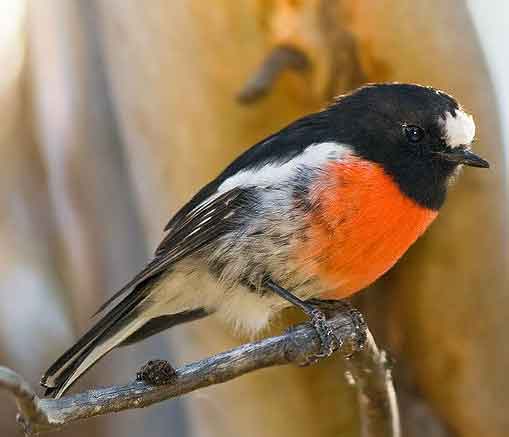
Petroica boodang (*)
Superregnum: Eukaryota
Cladus: Unikonta
Cladus: Opisthokonta
Cladus: Holozoa
Regnum: Animalia
Subregnum: Eumetazoa
Cladus: Bilateria
Cladus: Nephrozoa
Superphylum: Deuterostomia
Phylum: Chordata
Subphylum: Vertebrata
Infraphylum: Gnathostomata
Megaclassis: Osteichthyes
Cladus: Sarcopterygii
Cladus: Rhipidistia
Cladus: Tetrapodomorpha
Cladus: Eotetrapodiformes
Cladus: Elpistostegalia
Superclassis: Tetrapoda
Cladus: Reptiliomorpha
Cladus: Amniota
Classis: Reptilia
Cladus: Eureptilia
Cladus: Romeriida
Subclassis: Diapsida
Cladus: Sauria
Infraclassis: Archosauromorpha
Cladus: Crurotarsi
Divisio: Archosauria
Cladus: Avemetatarsalia
Cladus: Ornithodira
Subtaxon: Dinosauromorpha
Cladus: Dinosauriformes
Cladus: Dracohors
Cladus: Dinosauria
Ordo: Saurischia
Cladus: Eusaurischia
Subordo: Theropoda
Cladus: Neotheropoda
Cladus: Averostra
Cladus: Tetanurae
Cladus: Avetheropoda
Cladus: Coelurosauria
Cladus: Tyrannoraptora
Cladus: Maniraptoromorpha
Cladus: Maniraptoriformes
Cladus: Maniraptora
Cladus: Pennaraptora
Cladus: Paraves
Cladus: Eumaniraptora
Cladus: Avialae
Infraclassis: Aves
Cladus: Euavialae
Cladus: Avebrevicauda
Cladus: Pygostylia
Cladus: Ornithothoraces
Cladus: Ornithuromorpha
Cladus: Carinatae
Parvclassis: Neornithes
Cohors: Neognathae
Cladus: Neoaves
Cladus: Telluraves
Cladus: Australaves
Ordo: Passeriformes
Subordo: Passeri
Infraordo: Corvida
Superfamilia: Corvoidea
Familia: Petroicidae
Genus: Petroica
Species: Petroica boodang
Subspecies: P. b. boodang - P. b. campbelli - P. b. leggi
Name
Petroica boodang (Lesson, 1838)
Vernacular names
English: Scarlet Robin
suomi: Mustakurkkusieppo
中文: 緋紅鴝鶲
The scarlet robin (Petroica boodang) is a common red-breasted Australasian robin in the passerine bird genus Petroica. The species is found on continental Australia and its offshore islands, including Tasmania. The species was originally split in 1999 by Schodde and Mason,[3] and as the original collection by Gmelin was from Norfolk Island, this retained the name of multicolor, and is now known as the Norfolk robin.
Taxonomy
There are three recognised subspecies of Petroica boodang: the nominate subspecies P.b.boodang is found in mainland southeastern Australia; P.b.leggii is found in Tasmania and Flinders Island in the Bass Strait; and P.b.campbelli occurs in southwestern Western Australia.[4]
Description
Like the rest of the Australasian robins, the scarlet robins are stocky passerines with large heads. They range in size from 12 to 13.5 cm in length and weigh between 12 and 14 g. The plumage is sexually dimorphic. The males have black heads, backs and tails, black and white wings, a scarlet red breast, and white belly, forehead and rump. The female matches the male in pattern, but is duller, with brown plumage instead of black, a much more washed-out red on the breast, and a buff belly. Juvenile birds resemble the female without the reddish wash on the breast.[5]
Distribution, movements and habitat
The scarlet robin is endemic to Australia, where it is found near the coast from southern Queensland to central South Australia, Tasmania and southwest Western Australia. The species is mostly sedentary over its range, but some mainland populations undergo small local movements in the autumn and winter, either to more open habitats or to lower elevations.[5]
The scarlet robin is most commonly found in eucalyptus woodland and forest, from sea level to 1000 m, particularly the more open habitats with grassy and shrubby understories. During the winter, more open environments, including urban habitats, are frequented.[citation needed]
Behaviour
The scarlet robin feeds on arthropods, such as insects and spiders.[5] It adjusts its foraging behaviour seasonally, feeding mostly on the ground during the winter, but during the summer and spring prey is more commonly snatched from bark and foliage.[6]
Breeding biology
The scarlet robin is a territorial and monogamous species, and defends its nesting territories both from others of the same species and from pairs of the related flame robin.[7] Territories are established and breeding commences before the migratory flame robin arrives in its range (where the two co-occur).[7] Both the male and the female participate in selecting the nesting site, but only the female constructs the nest, a task which takes four to ten days.[8] The clutch size is between one and four eggs, with three being the average. The eggs are grey, green or pale blue, and marked with brown to olive-brown splotches and spots, usually concentrated around the large end. Only the females incubate the eggs, and the males feed the females on the nest.[8] The chicks hatch after 14 to 18 days. At first, they are brooded by the female and fed by the male; when brooding ends, they are fed by both parents.[5] Nesting success is generally low, between 8 and 40%. Scarlet robin nests are raided by snakes, and they are victims of brood parasitism by various species of cuckoo.[5]
See also
List of Australasian birds
List of Western Australian birds
References
BirdLife International (2017). "Petroica boodang". IUCN Red List of Threatened Species. 2017: e.T22735719A112749310. doi:10.2305/IUCN.UK.2017-1.RLTS.T22735719A112749310.en. Retrieved 13 November 2021.
"Petroica boodang". Avibase.
Schodde R, Mason IJ (1999). The Directory of Australian Birds: Passerines. A Taxonomic and Zoogeographic Atlas of the Biodiversity of Birds in Australia and its Territories. Collingwood, Australia: CSIRO Publishing. p. x 851 pp. ISBN 0-643-06456-7.
Gill, F. and D. Donsker, eds. (2020). IOC World Bird List (v 10.1). Doi 10.14344/IOC.ML.10.1. http://www.worldbirdnames.org/
Boles, W (2007) "Family Petroicidae (Australasian Robins)" in del Hoyo, J.; Elliot, A. and Christie D. (editors). (2007). Handbook of the Birds of the World. Volume 12: Picathartes to Tits and Chickadees. Lynx Editions. ISBN 978-84-96553-42-2 pp. 482–483
Robinson, D (1992). "Habitat use and foraging behaviour of the scarlet robin and the flame robin at a site of breeding-season sympatry". Wildlife Research. 19 (4): 377–395. doi:10.1071/WR9920377.
Robinson, D (1989). "Interspecific Aggression and Territorial Behavior Between Scarlet Robin Petroica multicolor and Flame Robin P. phoenicea". Emu. 89 (2): 93–101. doi:10.1071/MU9890093.
Robinson, D (1990). "The Nesting Ecology of Sympatric Scarlet Robin Petroica multicolor and Flame Robin Petroica phoenicea Populations in Open Eucalypt Forest". Emu. 90 (1): 40–52. doi:10.1071/MU9900040.
Retrieved from "http://en.wikipedia.org/"
All text is available under the terms of the GNU Free Documentation License

